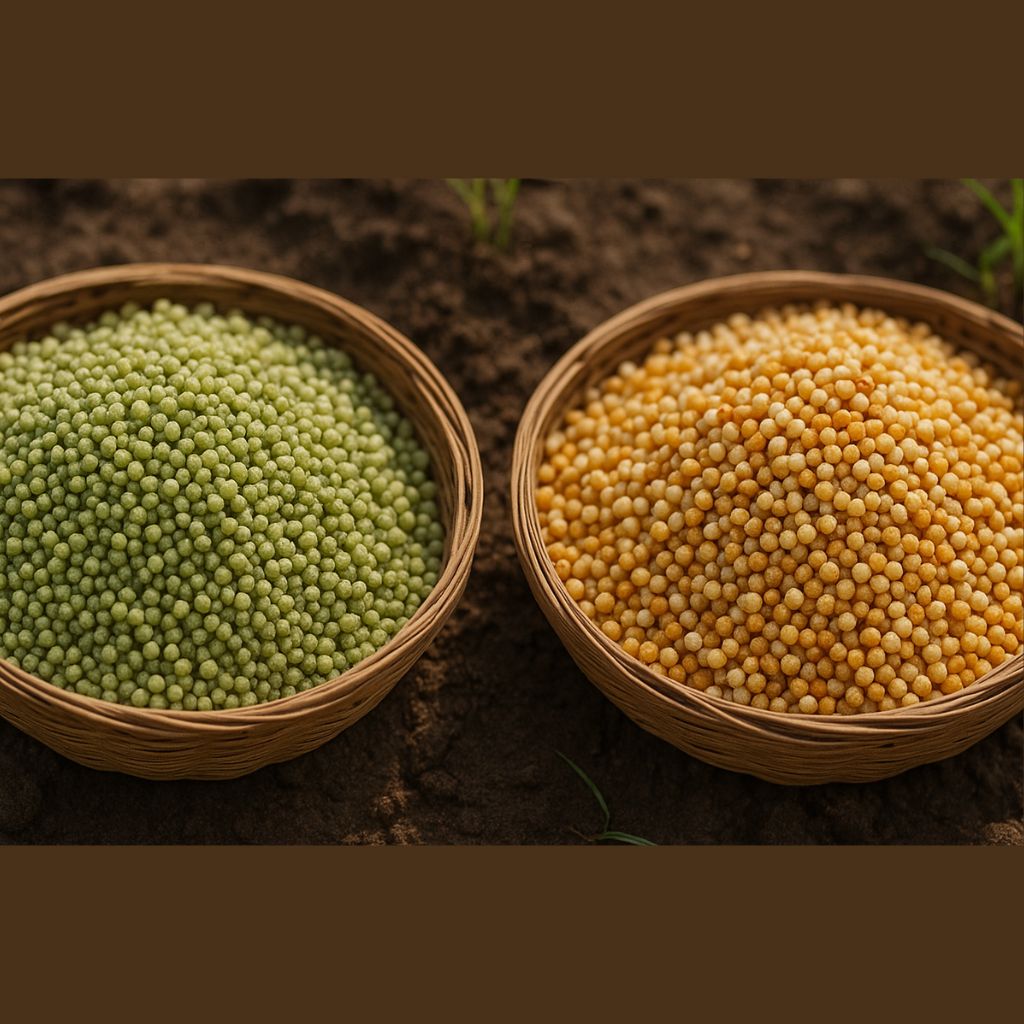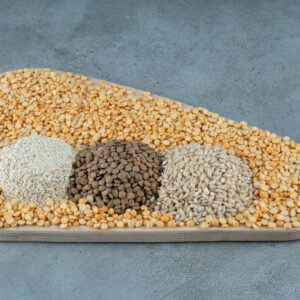Have you ever stood in the grocery aisle, staring at different millet varieties, wondering which one would benefit your health the most?
You’re not alone in this confusion. with 2023 being declared the International Year of Millets by the Indian government, these ancient grains have made a strong comeback to our kitchen shelves. But when it comes to Green Millet vs. Other Millets, making the right choice can feel overwhelming. In this detailed guide, I’ll break down everything you need to know about green millet compared to other popular millet varieties. You’ll discover their unique nutritional profiles, health benefits, and which one might be the perfect fit for your dietary needs.
What Exactly is Green Millet?
Green millet, also known as proso millet or white millet (Panicum miliaceum), is one of the oldest cultivated grains in the world. Despite its name, green millet usually appears pale yellow or cream-colored after processing. This ancient grain has been a staple food in many parts of Asia and Europe for thousands of years.
Key characteristics of green millet:
- Small, round grains
- Mild, slightly nutty flavor
- Quick cooking time (15-20 minutes)
- Naturally gluten-free
- Drought-resistant crop
Popular Millet Varieties: A Quick Overview
Before diving into the millets comparison, let’s understand the main players in the millet family:
Pearl Millet (Bajra)
The most widely cultivated millet globally. Rich in iron and zinc. Popular in Indian cuisine, especially in Rajasthan and Gujarat.
Finger Millet (Ragi)
Boasts the highest calcium content of all cereal grains and is 10 times richer in calcium than rice or wheat. Dark red or brown colored grains. Excellent for bone health.
Foxtail Millet (Kangni)
Small, golden-colored grains. Rich in protein content along with proso millet. Good for controlling blood sugar levels.
Little Millet (Kutki)
Tiny white grains. High in fiber and minerals. Great for weight management.
Green Millet vs. Other Millets: Nutritional Showdown
Let me break down the millet health benefits by comparing their nutritional profiles:
Protein Content Comparison
Protein content in millets ranges from 6 to 13%, with proso millet and foxtail millet being the richest sources.
Green millet (Proso) leads the pack with:
- 11-13% protein content
- Complete amino acid profile
- High levels of lecithin, supporting neural health and liver function
Other millets:
- Pearl millet: 10-12% protein
- Finger millet: 7-8% protein
- Foxtail millet: 11-12% protein
- Little millet: 8-10% protein
Mineral Content Battle
Green Millet advantages:
- High in essential minerals like magnesium and phosphorus
- Rich in potassium and zinc
- Good source of B-vitamins
Finger Millet wins in calcium:
- Provides 13% of the daily value per cooked cup
- 3 times more calcium than milk
Pearl Millet excels in iron:
- Highest iron content among all millets
- Great for preventing anemia
Fiber and Carbohydrate Content
All millets are excellent sources of dietary fiber, but here’s how they stack up:
Green millet:
- 8-10% fiber content
- Complex carbohydrates for sustained energy
- Low glycemic index
Comparison with others:
- Pearl millet: 10-12% fiber
- Finger millet: 11-15% fiber
- Foxtail millet: 6-8% fiber
Health Benefits: Green Millet vs. Other Millets
Green Millet Health Benefits
Heart Health Champion: Excellent choice for heart health and managing cholesterol levels. The magnesium content helps regulate blood pressure. Rich in antioxidants that protect against cardiovascular diseases.
Digestive Health: High fiber content promotes healthy digestion. Prebiotic properties support gut microbiome. Helps prevent constipation and promotes regular bowel movements.
Weight Management: Low glycemic index helps with blood sugar control. High protein and fiber keep you feeling full longer. Supports healthy metabolism.
Other Millets’ Unique Benefits
Finger Millet (Ragi):
- Bone Health Superstar: Unmatched calcium content strengthens bones and teeth
- Anemia Prevention: Good iron content supports healthy blood formation
- Diabetes Management: Helps control blood sugar spikes
Pearl Millet (Bajra):
- Iron Powerhouse: Best choice for treating iron deficiency
- Energy Booster: High calorie content provides sustained energy
- Cold Weather Food: Generates body heat, perfect for winter months
Foxtail Millet:
- Brain Health: Rich in vitamin B1 (thiamine) for cognitive function
- Immunity Booster: High antioxidant content strengthens immune system
- Skin Health: Contains copper for healthy skin and hair
Cooking and Taste Comparison
Green Millet in the Kitchen
Cooking characteristics:
- Cooks fastest among all millets (15-20 minutes)
- Fluffy texture when cooked properly
- Mild, slightly sweet flavor
- Versatile for both sweet and savory dishes
Best uses:
- Morning porridge
- Pulao and biryanis
- Baking applications
- Baby food preparation
Other Millets’ Cooking Properties
Pearl Millet:
- Takes 25-30 minutes to cook
- Dense, hearty texture
- Strong, earthy flavor
- Best for rotis and traditional dishes
Finger Millet:
- Requires 20-25 minutes cooking time
- Slightly sticky texture
- Nutty, rich flavor
- Perfect for porridge and baked goods
Foxtail Millet:
- Cooks in 20 minutes
- Light, fluffy texture
- Mild taste
- Great rice substitute
Which Millet Should You Choose?
The answer depends on your specific health goals and preferences:
Choose Green Millet If:
- You want the highest protein content
- Heart health is your priority
- You need quick-cooking options
- You’re new to millets (mild taste)
- You want versatile cooking applications
Choose Finger Millet If:
- Bone health is your main concern
- You’re lactose intolerant but need calcium
- You have growing children at home
- You enjoy rich, nutty flavors
Choose Pearl Millet If:
- You’re dealing with iron deficiency
- You need high-energy foods
- You live in colder climates
- You enjoy traditional Indian flavors
Choose Foxtail Millet If:
- You want a direct rice replacement
- Brain health is important to you
- You prefer light, fluffy textures
- You’re managing diabetes
Tips for Including Millets in Your Diet
Start gradually: Begin with 2-3 times per week. Mix with familiar grains initially. Experiment with different recipes.
Preparation tips: Always wash millets thoroughly before cooking. Soak for 30 minutes for better digestibility. Use 1:2.5 ratio (millet to water) for cooking.
Storage advice: Store in airtight containers. Keep in cool, dry places. Use within 6 months for best quality.
Common Myths About Millets Debunked
Myth 1: “Millets are only for rural areas” Truth: Urban dietitians now recommend millets for their superior nutrition profile.
Myth 2: “All millets taste the same” Truth: Each variety has its unique flavor and texture characteristics.
Myth 3: “Millets are difficult to cook” Truth: Most millets cook faster than brown rice and are quite simple to prepare.
The Environmental Advantage
Why millets matter for sustainability:
- Require minimal water compared to rice and wheat
- Grow well in arid conditions
- Support biodiversity
- Reduce carbon footprint
- Support small farmers
Millets are favored for their productivity and short growing season under hot dry conditions, making them crucial for climate-resilient agriculture.
Conclusion
The debate of Green Millet vs. Other Millets doesn’t have a single winner because each variety offers unique nutritional advantages. Green millet stands out for its exceptional protein content, heart-healthy properties, and cooking versatility. However, finger millet wins for calcium content, while pearl millet excels in iron. The best approach is to include a variety of millets in your diet to maximize the diverse millet health benefits.
Start with green millet if you’re new to this ancient grain family its mild taste and quick cooking time make it beginner-friendly. Remember, the journey to better health doesn’t require choosing just one superfood. By understanding the strengths of different millet varieties, you can make informed decisions that align with your health goals and taste preferences. Your path to better nutrition through Green Millet vs. Other Millets starts with that first delicious, wholesome meal.
Frequently Asked Questions
Q1: Can I eat different types of millets together?
Yes, mixing different millets creates a more complete nutritional profile and adds interesting flavors and textures to your meals.
Q2: How much millet should I consume daily?
Start with 1/4 to 1/2 cup of cooked millet per day, gradually increasing based on your tolerance and dietary needs.
Q3: Are millets suitable for diabetics?
Absolutely! Millets have a low glycemic index, making them excellent for blood sugar management and diabetes control.
Q4: Can children eat millets regularly?
Yes, millets are safe and highly nutritious for children. Finger millet is particularly beneficial for growing kids due to calcium content.
Q5: Do millets cause any side effects?
Millets are generally safe, but excessive consumption may cause digestive issues in some people. Start with small portions initially.





